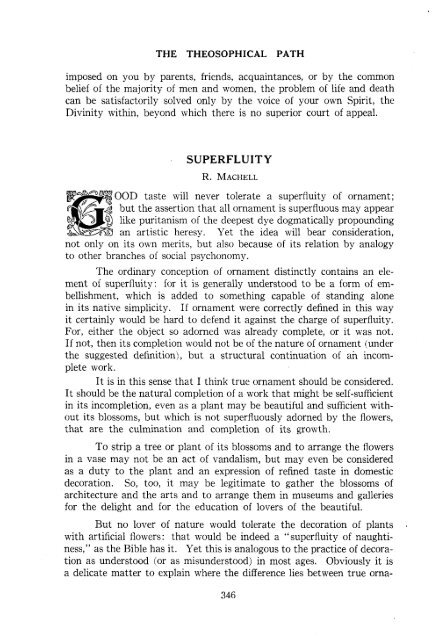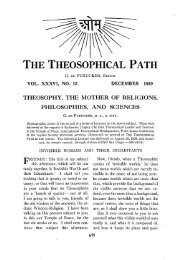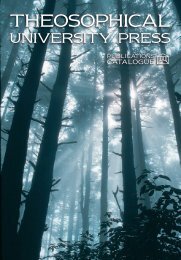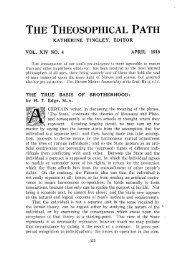vol. xxx, no. 4 april 1926 universal brotherhood - a fact in nature
vol. xxx, no. 4 april 1926 universal brotherhood - a fact in nature
vol. xxx, no. 4 april 1926 universal brotherhood - a fact in nature
You also want an ePaper? Increase the reach of your titles
YUMPU automatically turns print PDFs into web optimized ePapers that Google loves.
THE THEOSOPHICAL PATH<br />
imposed on you by parents, friends, acqua<strong>in</strong>tances, or by the common<br />
belief of the majority of men and women, the problem of life and death<br />
can be satis<strong>fact</strong>.orily solved only by the voice of your own Spirit, the<br />
Div<strong>in</strong>ity with<strong>in</strong>, beyond which there is <strong>no</strong> superior court of appeal.<br />
SUPERFLUITY<br />
taste will never tolerate a superfluity of ornament;<br />
but the assertion that all ornament is superfluous may appear<br />
puritanism of the deepest dye dogmatically propound<strong>in</strong>g<br />
heresy. Yet the idea will bear consideration,<br />
<strong>no</strong>t only on its own merits, but also because of its relation by analogy<br />
to other branches of social psycho<strong>no</strong>my.<br />
The ord<strong>in</strong>ary conception of ornament dist<strong>in</strong>ctly conta<strong>in</strong>s an ele-<br />
ment of superfluity: for it is generally understood to be a form of em-<br />
bellishment, which is added to someth<strong>in</strong>g capable of stand<strong>in</strong>g alone<br />
<strong>in</strong> its native simplicity. If ornament were correctly def<strong>in</strong>ed <strong>in</strong> this way<br />
it certa<strong>in</strong>ly would be hard to defend it aga<strong>in</strong>st the charge of superfluity.<br />
For, either the object so adorned was already complete, or it was <strong>no</strong>t.<br />
If <strong>no</strong>t, then its completion would <strong>no</strong>t be of the <strong>nature</strong> of ornament (under<br />
the suggested def<strong>in</strong>ition), but a structural cont<strong>in</strong>uation of an <strong>in</strong>com-<br />
plete work.<br />
It is <strong>in</strong> this sense that I th<strong>in</strong>k true ornament should be considered.<br />
It should be the natural completion of a work that might be self-sufficient<br />
<strong>in</strong> its <strong>in</strong>completion, even as a plant may be beautiful and sufficient with-<br />
out its blossoms, but which is <strong>no</strong>t superfluously adorned by the flowers,<br />
that are the culm<strong>in</strong>ation and completion of its growth.<br />
To strip a tree or plant of its blossoms and to arrange the flowers<br />
<strong>in</strong> a vase may <strong>no</strong>t be an act of vandalism, but may even be considered<br />
as a duty to the plant and an expression of ref<strong>in</strong>ed taste <strong>in</strong> domestic<br />
decoration. So, too, it may be legitimate to gather the blossoms of<br />
architecture and the arts and to arrange them <strong>in</strong> museums and galleries<br />
for the delight and for the education of lovers of the beautiful.<br />
But <strong>no</strong> lover of <strong>nature</strong> would tolerate the decoration of plants .<br />
with artificial flowers: that would be <strong>in</strong>deed a "superfluity of naughti-<br />
ness," as the Bible has it. Yet this is analogous to the practice of decora-<br />
tion as understood !or as misunderstood) <strong>in</strong> most ages. Obviously it is<br />
a delicate matter to expla<strong>in</strong> where the difference lies between true orna-













